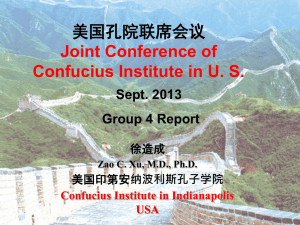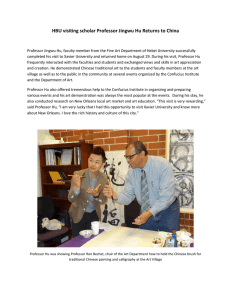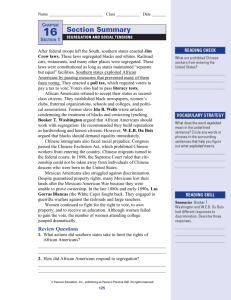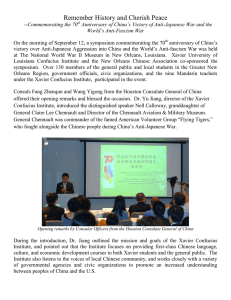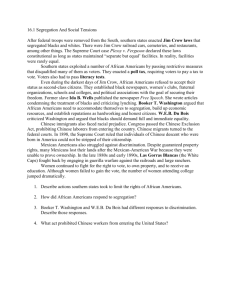When Bright Minds Met: Xavier Confucius Institute Hosting
advertisement
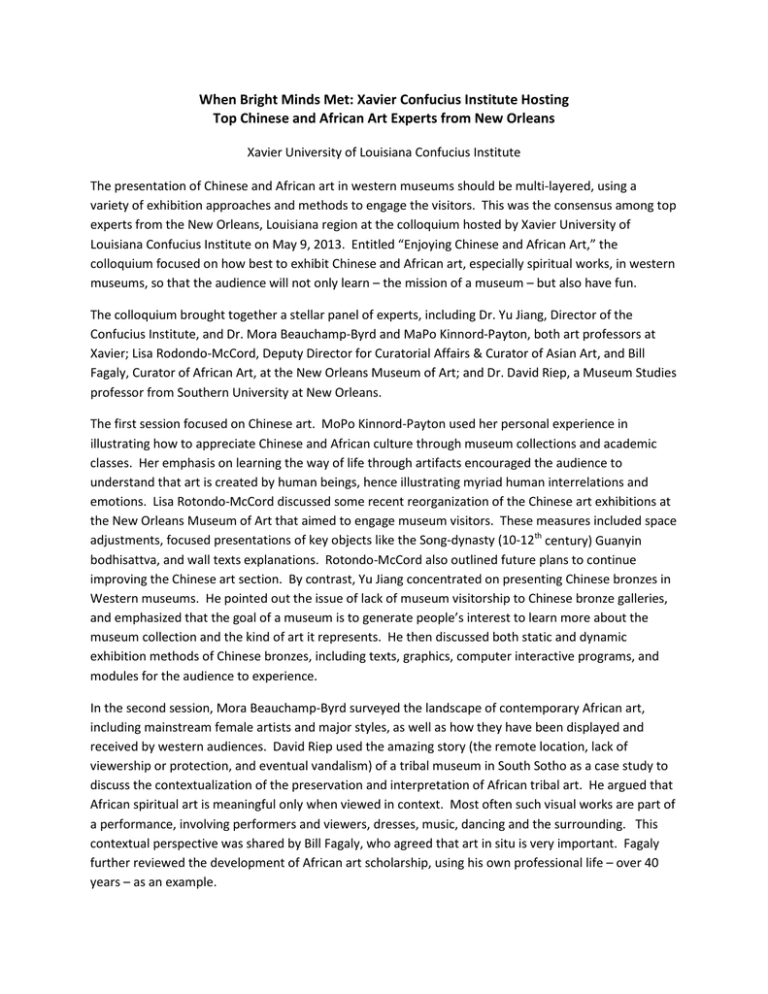
When Bright Minds Met: Xavier Confucius Institute Hosting Top Chinese and African Art Experts from New Orleans Xavier University of Louisiana Confucius Institute The presentation of Chinese and African art in western museums should be multi-layered, using a variety of exhibition approaches and methods to engage the visitors. This was the consensus among top experts from the New Orleans, Louisiana region at the colloquium hosted by Xavier University of Louisiana Confucius Institute on May 9, 2013. Entitled “Enjoying Chinese and African Art,” the colloquium focused on how best to exhibit Chinese and African art, especially spiritual works, in western museums, so that the audience will not only learn – the mission of a museum – but also have fun. The colloquium brought together a stellar panel of experts, including Dr. Yu Jiang, Director of the Confucius Institute, and Dr. Mora Beauchamp-Byrd and MaPo Kinnord-Payton, both art professors at Xavier; Lisa Rodondo-McCord, Deputy Director for Curatorial Affairs & Curator of Asian Art, and Bill Fagaly, Curator of African Art, at the New Orleans Museum of Art; and Dr. David Riep, a Museum Studies professor from Southern University at New Orleans. The first session focused on Chinese art. MoPo Kinnord-Payton used her personal experience in illustrating how to appreciate Chinese and African culture through museum collections and academic classes. Her emphasis on learning the way of life through artifacts encouraged the audience to understand that art is created by human beings, hence illustrating myriad human interrelations and emotions. Lisa Rotondo-McCord discussed some recent reorganization of the Chinese art exhibitions at the New Orleans Museum of Art that aimed to engage museum visitors. These measures included space adjustments, focused presentations of key objects like the Song-dynasty (10-12th century) Guanyin bodhisattva, and wall texts explanations. Rotondo-McCord also outlined future plans to continue improving the Chinese art section. By contrast, Yu Jiang concentrated on presenting Chinese bronzes in Western museums. He pointed out the issue of lack of museum visitorship to Chinese bronze galleries, and emphasized that the goal of a museum is to generate people’s interest to learn more about the museum collection and the kind of art it represents. He then discussed both static and dynamic exhibition methods of Chinese bronzes, including texts, graphics, computer interactive programs, and modules for the audience to experience. In the second session, Mora Beauchamp-Byrd surveyed the landscape of contemporary African art, including mainstream female artists and major styles, as well as how they have been displayed and received by western audiences. David Riep used the amazing story (the remote location, lack of viewership or protection, and eventual vandalism) of a tribal museum in South Sotho as a case study to discuss the contextualization of the preservation and interpretation of African tribal art. He argued that African spiritual art is meaningful only when viewed in context. Most often such visual works are part of a performance, involving performers and viewers, dresses, music, dancing and the surrounding. This contextual perspective was shared by Bill Fagaly, who agreed that art in situ is very important. Fagaly further reviewed the development of African art scholarship, using his own professional life – over 40 years – as an example. In the afternoon, Rotondo-McCord, Jiang, Fagaly, and Jingwu Hu, a visiting art faculty from Hebei University, gave the audience a tour of the Chinese and African art collections at the New Orleans Museum of Art. Through this colloquium, the Confucius Institute at Xavier created a dialogue among top local experts on Chinese and African art. By investigating contextual meaning of art and their interpretation and presentation in museums, the colloquium enhanced people’s understanding of the sociopolitical functions of these artworks. 智者相约 聚义研讨 记泽维尔大学孔子学院主持召开新奥尔良地区高端中非艺术研讨会 西方博物馆内中国和非洲艺术展应详尽各种方式和方法,向参观者多层面呈现其艺术魅力和内涵。 这是 2013 年 5 月 9 日泽维尔大学孔子学院主持召开的路易斯安娜州新奥尔良地区高端博物馆艺 术研讨会上专家们达到的共识。研讨会以“欣赏中非艺术”命名,聚焦西方博物馆中非艺术,尤其 是还有宗教意义作品的展出,突显博物馆使命,以达寓教于乐之目的。 此次研讨聚集了众多著名学者,其中包括泽维尔大学孔子学院院长江瑜博士、泽维尔大学艺术副 教授马坡和助理教授兼大学艺术馆员莫拉博士;负责新奥尔良艺术博物馆日常工作和亚洲艺术的 副馆长梦莎女士、新奥尔良艺术博物馆非洲艺术特邀研究员比尔.法加利和新奥尔良南方大学博物 馆学助理教授大卫.利普先生。 研讨会分前后半程进行。前半程首先探讨了中国艺术。马坡教授用自己的亲身经历介绍了如何利 用博物馆收藏和课堂欣赏中国和非洲艺术。她对通过艺术作品获取的生活方式进行了阐述,激励 听众去理解艺术是人类创造的,同时也表现人类相互关系和情感的多样性和多重性。新奥尔良艺 术博物馆副馆长梦莎女士回顾了该馆重组中国艺术展厅的一些重要举措,旨在增加博物馆参观人 数,包括空间调整、标签设计、还有镇馆之宝一件宋代(10 至 12 世纪)观音菩萨的位置处理等。 梦莎副馆长勾勒说明了未来继续改善中国艺术展区的计划。孔子学院院长江瑜博士集中讨论了西 方博物馆如何展出中国青铜器问题。江瑜博士指出了中国青铜器艺术馆展出访客不足,并指出博 物馆宗旨在于如何让来访者对馆藏物品及其所代表的艺术门类产生兴趣。江瑜博士又进一步讨论 了青铜器的静态和动态的展示方法。这些方法包括文字、图标、计算机辅助互动和让参观者体验 的模块设计。 研讨会的后半程有三位专家展示了他们的研究成果。莫拉博士为听众做了当代非洲艺术展望,其 中包括主流女性艺术家及其风格和非洲艺术家是如何展示并被西方观众接受的。大卫.利普教授利 用南非梭托人的部落博物馆的一个令人惊讶的故事(位置偏僻、缺少观众和保护、最终遭受破坏) 展示了他所做的个案研究。他主张非洲宗教意义作品只有在有观众参加下才有意义。很多时候这 些视觉作品是部落宗教表演的一部分。这包括了表演者、观众、服装、音乐、舞蹈和周边环境。 这一基于环境的论点得到了新奥尔良艺术博物馆非洲艺术特邀研究员比尔.法加利的赞同。他同意 具体内涵、场景等对理解和欣赏非洲宗教性艺术的重要性,并用自己长达 40 年的专业生涯进一 步说明了非洲艺术的发展。 研讨会当天下午梦莎副馆长、江瑜博士、比尔. 法加利研究员和河北大学访问学者胡京武副教授 带领与会人员参观了新奥尔良艺术博物馆中国和非洲艺术珍藏并作了精辟的解说。 以本次高端研讨会为平台,泽维尔大学孔子学院成功举行地方性高端中非艺术对话。通过 对艺术语境的探讨与释义以及博物馆展出方式的讨论,研讨会提升和深化了大家对艺术作品社会 政治作用的理解。
